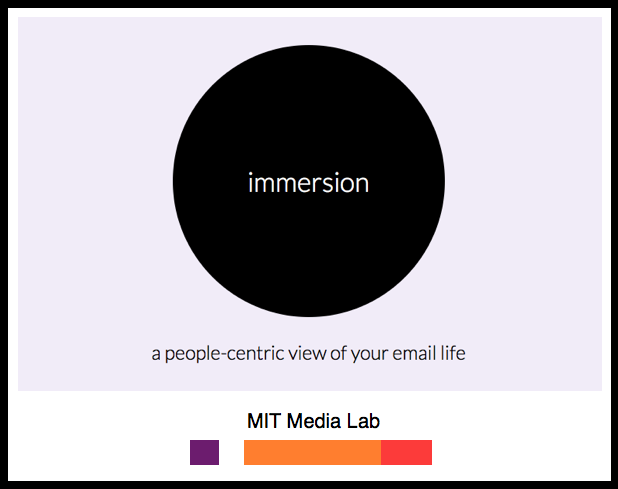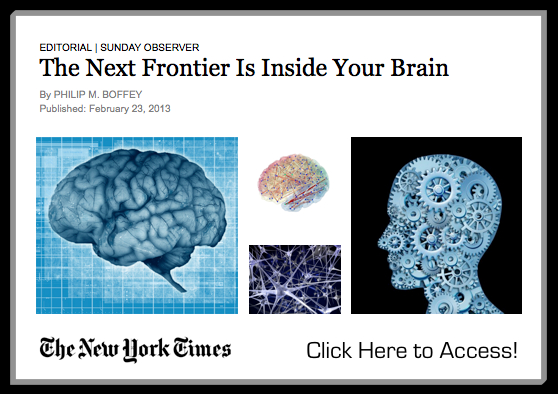Tag: network analysis
Network Analysis and the Law — 3D-Hi-Def Visualization of the Time Evolving Citation Network of the United States Supreme Court

What are some of the key takeaway points?
(1) The Supreme Court’s increasing reliance upon its own decisions over the 1800-1830 window.
(2) The important role of maritime/admiralty law in the early years of the Supreme Court’s citation network. At least with respect to the Supreme Court’s citation network, these maritime decisions are the root of the Supreme Court’s jurisprudence.
(3) The increasing centrality of decisions such as Marbury v. Madison, Martin v. Hunter’s Lessee to the overall network.
The Development of Structure in the SCOTUS Citation Network
The visualization offered above is the largest weakly connected component of the citation network of the United States Supreme Court (1800-1829). Each time slice visualizes the aggregate network as of the year in question.
In our paper entitled Distance Measures for Dynamic Citation Networks, we offer some thoughts on the early SCOTUS citation network. In reviewing the visual above note ….“[T]he Court’s early citation practices indicate a general absence of references to its own prior decisions. While the court did invoke well-established legal concepts, those concepts were often originally developed in alternative domains or jurisdictions. At some level, the lack of self-reference and corresponding reliance upon external sources is not terribly surprising. Namely, there often did not exist a set of established Supreme Court precedents for the class of disputes which reached the high court. Thus, it was necessary for the jurisprudence of the United States Supreme Court, seen through the prism of its case-to-case citation network, to transition through a loading phase. During this loading phase, the largest weakly connected component of the graph generally lacked any meaningful clustering. However, this sparsely connected graph would soon give way, and by the early 1820’s, the largest weakly connected component displayed detectable structure.”
What are the elements of the network?

What are the labels?
To help orient the end-user, the visualization highlights several important decisions of the United States Supreme Court offered within the relevant time period:
Marbury v. Madison, 5 U.S. 137 (1803) we labeled as ”Marbury”
Murray v. The Charming Betsey, 6 U.S. 64 (1804) we labeled as “Charming Betsey” Martin v. Hunter’s Lessee, 14 U.S. 304 (1816) we labeled as “Martin’s Lessee”
The Anna Maria, 15 U.S. 327 (1817) we labeled as “Anna Maria”
McCulloch v. Maryland, 17 U.S. 316 (1819) we labeled as “McCulloch”
Why do cases not always enter the visualization when they are decided?
As we are interested in the core set of cases, we are only visualizing the largest weakly connected component of the United States Supreme Court citation network. Cases are not added until they are linked to the LWCC. For example, Marbury v. Madison is not added to the visualization until a few years after it is decided.
How do I best view the visualization?
Given this is a high-definition video, it may take few seconds to load. We believe that it is worth the wait. In our view, the video is best consumed (1) Full Screen (2) HD On (3) Scaling Off.
Where can I find related papers?
Here is a non-exhaustive list of related scholarship:
Daniel Martin Katz, Network Analysis Reveals the Structural Position of Foreign Law in the Early Jurisprudence of the United States Supreme Court (Working Paper – 2014)
Yonatan Lupu & James H. Fowler, Strategic Citations to Precedent on the U.S. Supreme Court, 42 Journal of Legal Studies 151 (2013)
Michael Bommarito, Daniel Martin Katz, Jon Zelner & James Fowler, Distance Measures for Dynamic Citation Networks, 389 Physica A 4201 (2010).
Michael Bommarito, Daniel Martin Katz & Jon Zelner, Law as a Seamless Web? Comparison of Various Network Representations of the United States Supreme Court Corpus (1791-2005) in Proceedings of the 12th Intl. Conference on Artificial Intelligence and Law (2009).
Frank Cross, Thomas Smith & Antonio Tomarchio, The Reagan Revolution in the Network of Law, 57 Emory L. J. 1227 (2008).
James Fowler & Sangick Jeon, The Authority of Supreme Court Precedent, 30 Soc. Networks 16 (2008).
Elizabeth Leicht, Gavin Clarkson, Kerby Shedden & Mark Newman, Large-Scale Structure of Time Evolving Citation Networks, 59 European Physics Journal B 75 (2007).
Thomas Smith, The Web of the Law, 44 San Diego L.R. 309 (2007).
James Fowler, Timothy R. Johnson, James F. Spriggs II, Sangick Jeon & Paul J. Wahlbeck, Network Analysis and the Law: Measuring the Legal Importance of Precedents at the U.S. Supreme Court, 15 Political Analysis, 324 (2007).
Network Analysis and Law Tutorial – Katz + Bommarito
Above is a tutorial that Mike and I developed for the Jurix Conference in Vienna in December of 2011. Feel free to message if I can answer any questions.
Measuring the Complexity of the Law: The United States Code (By Daniel Martin Katz & Michael J. Bommarito)
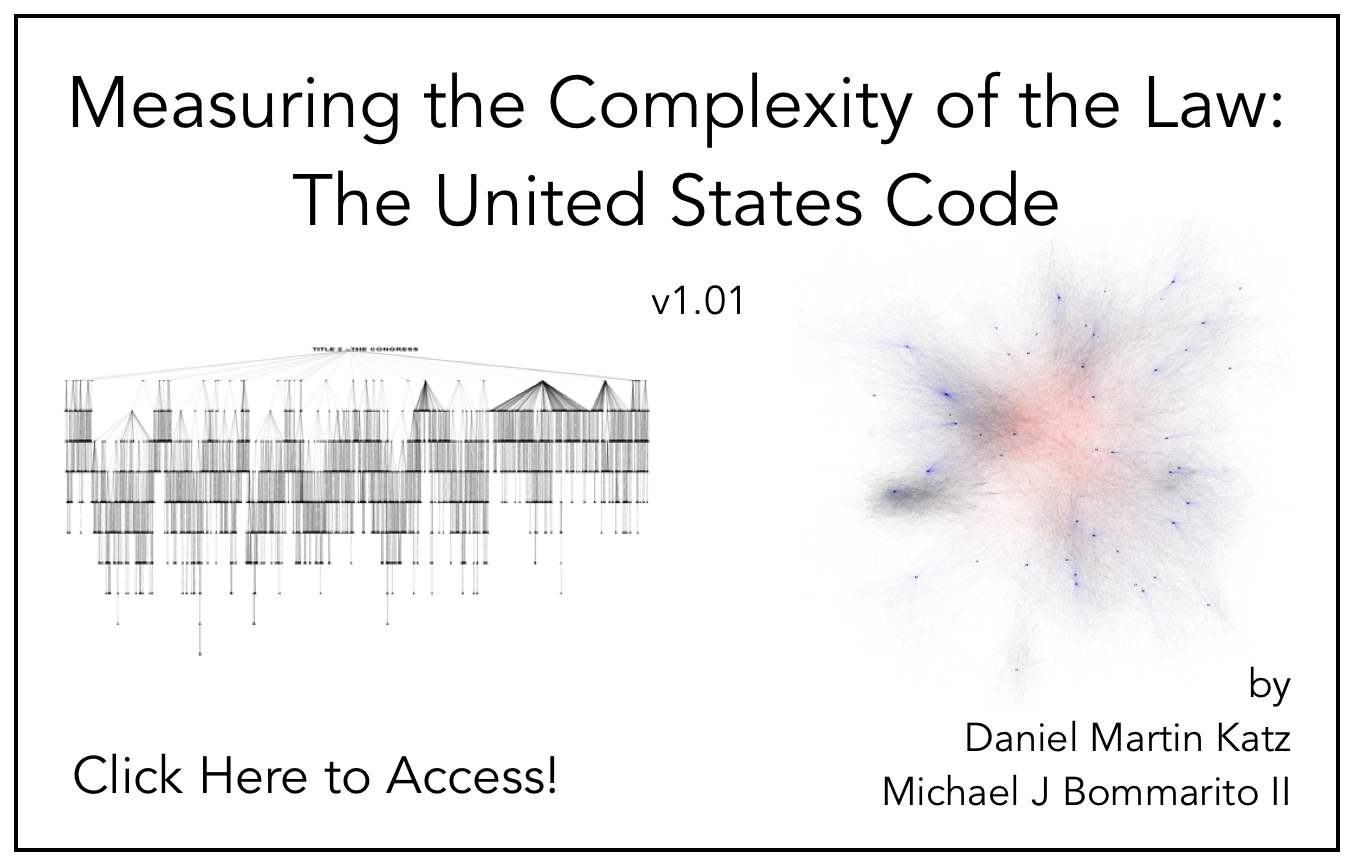 From our abstract: “Einstein’s razor, a corollary of Ockham’s razor, is often paraphrased as follows: make everything as simple as possible, but not simpler. This rule of thumb describes the challenge that designers of a legal system face—to craft simple laws that produce desired ends, but not to pursue simplicity so far as to undermine those ends. Complexity, simplicity’s inverse, taxes cognition and increases the likelihood of suboptimal decisions. In addition, unnecessary legal complexity can drive a misallocation of human capital toward comprehending and complying with legal rules and away from other productive ends.
From our abstract: “Einstein’s razor, a corollary of Ockham’s razor, is often paraphrased as follows: make everything as simple as possible, but not simpler. This rule of thumb describes the challenge that designers of a legal system face—to craft simple laws that produce desired ends, but not to pursue simplicity so far as to undermine those ends. Complexity, simplicity’s inverse, taxes cognition and increases the likelihood of suboptimal decisions. In addition, unnecessary legal complexity can drive a misallocation of human capital toward comprehending and complying with legal rules and away from other productive ends.
While many scholars have offered descriptive accounts or theoretical models of legal complexity, empirical research to date has been limited to simple measures of size, such as the number of pages in a bill. No extant research rigorously applies a meaningful model to real data. As a consequence, we have no reliable means to determine whether a new bill, regulation, order, or precedent substantially effects legal complexity.
In this paper, we address this need by developing a proposed empirical framework for measuring relative legal complexity. This framework is based on “knowledge acquisition,” an approach at the intersection of psychology and computer science, which can take into account the structure, language, and interdependence of law. We then demonstrate the descriptive value of this framework by applying it to the U.S. Code’s Titles, scoring and ranking them by their relative complexity. Our framework is flexible, intuitive, and transparent, and we offer this approach as a first step in developing a practical methodology for assessing legal complexity.”
This is a draft version so we invite your comments (katzd@law.msu.edu) and (michael.
UPDATE: Paper was named “Download of the Week” by Legal Theory Blog.
Global Patent Map Reveals the Structure of Technological Progress (via MIT Technology Review)
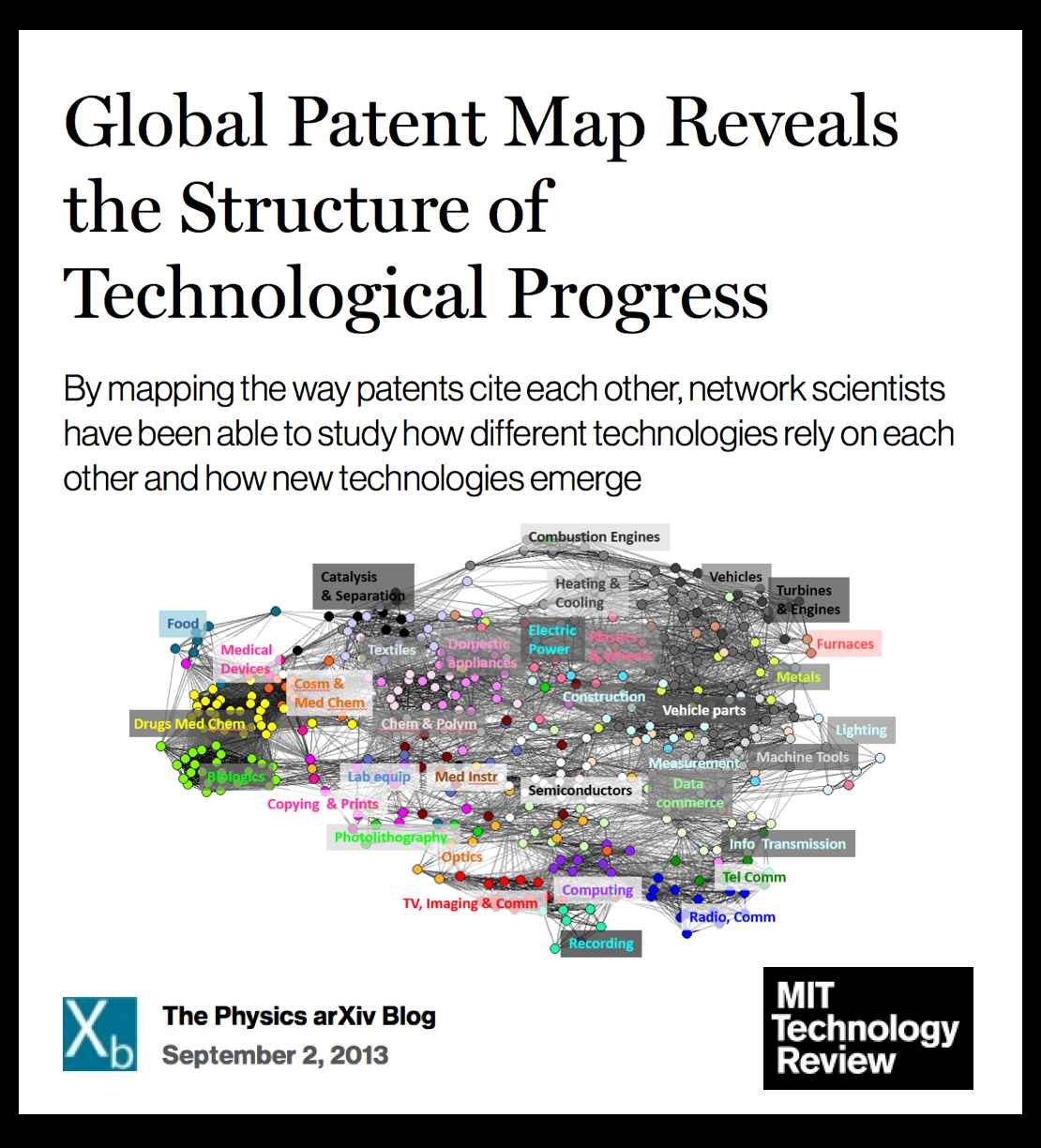 This is topic of great interest for a number of reasons. Mike, Jon and I have several papers in this basic direction (with hopefully more coming soon). Probably the most relevant of our paper is “Distance Measures for Dynamic Citation Networks” which we published in Physica A back in late-2010. For those who might be interested – a copy of our paper (with James H. Fowler) is available on SSRN and on ArXiv.
This is topic of great interest for a number of reasons. Mike, Jon and I have several papers in this basic direction (with hopefully more coming soon). Probably the most relevant of our paper is “Distance Measures for Dynamic Citation Networks” which we published in Physica A back in late-2010. For those who might be interested – a copy of our paper (with James H. Fowler) is available on SSRN and on ArXiv.
Complex Systems Models in the Social Science @ UMich ICPSR Summer Program in Quantitative Methods
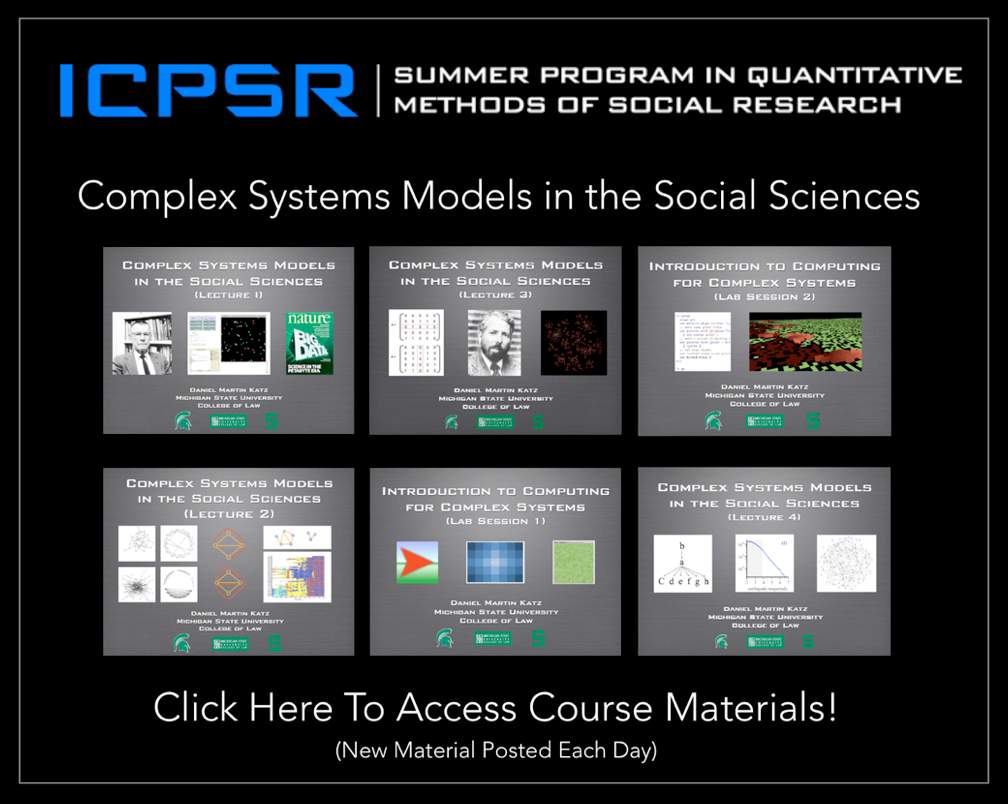 This week and next week I have the pleasure of teaching “Complex Systems Models in the Social Sciences” here at the University of Michigan ICPSR Summer Program in Quantitative Methods. The field of complex systems is very diverse and it is difficult to do complete justice to the range of scholarship conducted under this umbrella. However, we strive to cover the canonical topics such as computational game theory and computational modeling, network science, natural language processing, randomness vs. determinism, diffusion, cascades, emergence, empirical approaches to study complexity (including measurement), social epidemiology, non-linear dynamics, etc.
This week and next week I have the pleasure of teaching “Complex Systems Models in the Social Sciences” here at the University of Michigan ICPSR Summer Program in Quantitative Methods. The field of complex systems is very diverse and it is difficult to do complete justice to the range of scholarship conducted under this umbrella. However, we strive to cover the canonical topics such as computational game theory and computational modeling, network science, natural language processing, randomness vs. determinism, diffusion, cascades, emergence, empirical approaches to study complexity (including measurement), social epidemiology, non-linear dynamics, etc.
International Conference on Artificial Intelligence and Law (Rome 2013 – Registration is Now Open!)
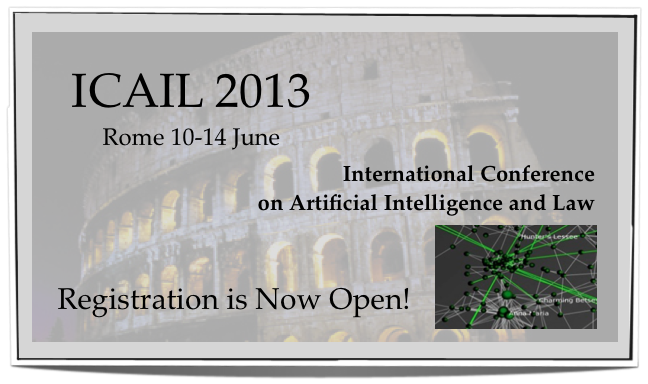 As a member of the AI+Law 2013 Program Committee it is my pleasure to invite you to attend the International Conference on Artificial Intelligence and Law – Rome 2013 — June 10-14. The conference will feature the core program of peer reviewed papers, research abstracts and project demos. In addition, the conference features two days of workshops and tutorials in topics such as Computational Models of Natural Argument, Textual Extraction from Legal Resources, Machine Learning in E-Discovery, Network Analysis in Law, XML Schemas for Legal Rules, Data Driven Artificial Intelligence in Law, etc.
As a member of the AI+Law 2013 Program Committee it is my pleasure to invite you to attend the International Conference on Artificial Intelligence and Law – Rome 2013 — June 10-14. The conference will feature the core program of peer reviewed papers, research abstracts and project demos. In addition, the conference features two days of workshops and tutorials in topics such as Computational Models of Natural Argument, Textual Extraction from Legal Resources, Machine Learning in E-Discovery, Network Analysis in Law, XML Schemas for Legal Rules, Data Driven Artificial Intelligence in Law, etc.
I hope to see you in Rome this Summer for AI+Law 2013!
How the Science of Swarms Can Help Us Fight Cancer and Predict the Future {via Wired}
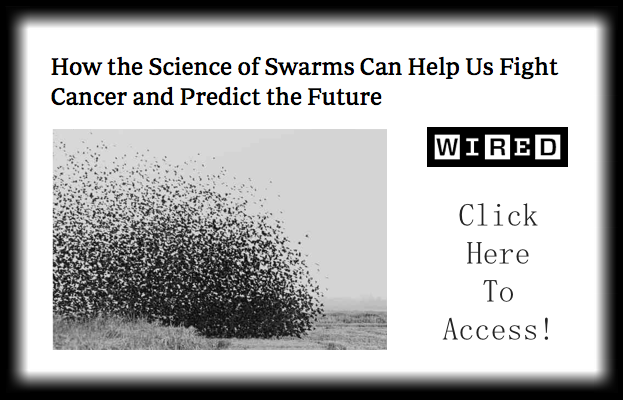
We cover the topic of Swarms at great length in the “Complex Systems in the Social Sciences Course” that I co-teach at the University of Michigan ICPSR Summer Program in Quantitative Methods. If you are interested in learning more here are some of the slides from last year. The 2013 Edition of the Course Begins in July in Ann Arbor!
Workshop “Network Analysis in Law” @ International Conference on Artificial Intelligence and Law – Rome 2013
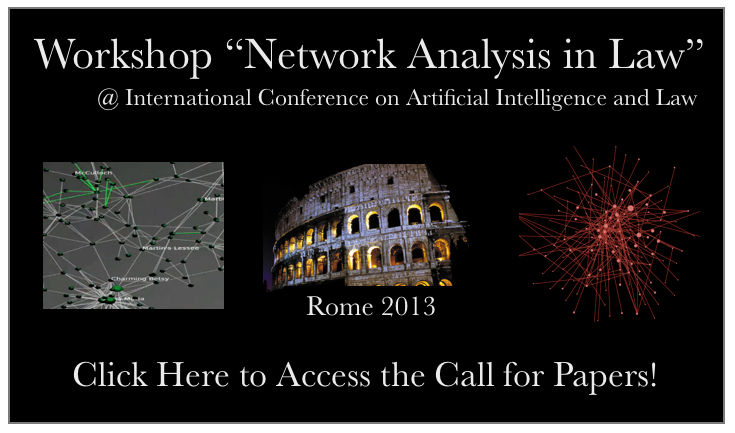 This Workshop builds upon the “Network Analysis and the Law” Tutorial that Mike Bommarito and I ran at Jurix 2011 in Vienna.
This Workshop builds upon the “Network Analysis and the Law” Tutorial that Mike Bommarito and I ran at Jurix 2011 in Vienna.
It was a great honor to be an organizer for both the overall Artificial Intelligence and Law 2013 Conference as well as the Network Analysis and Law workshop.
Looking forward to great week of rigorous technical papers at Artificial Intelligence and Law 2013 in Rome in early June!
Le Graph du Code Civil en Ligne – Interactive Network Visualization of French Civil Code
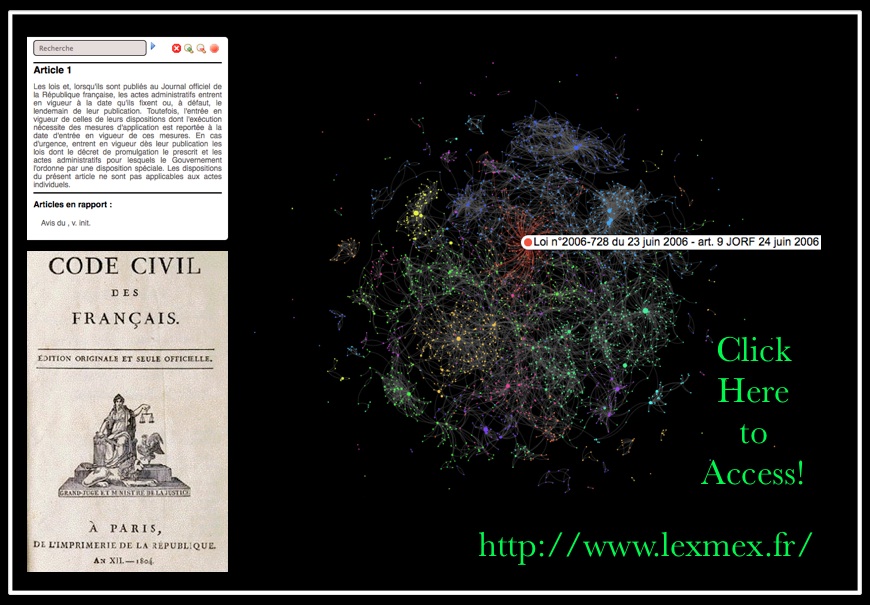 <HT: Robert Richards from Legal Informatics Blog >
<HT: Robert Richards from Legal Informatics Blog >
Automatic Prediction Of Small Group Performance In Information Sharing Tasks {from MIT Media Lab}
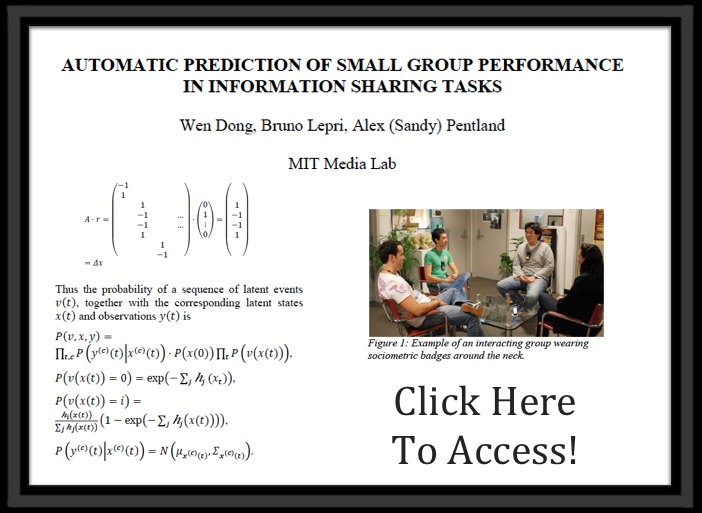
Abstract: “In this paper, we describe a novel approach, based on Markov jump processes, to model small group conversational dynamics and to predict small group performance. More precisely, we estimate conversational events such as turn taking, backchannels, turn-transitions at the micro-level (1 minute windows) and then we bridge the micro-level behavior and the macro-level performance. We tested our approach with a cooperative task, the Information Sharing task, and we verified the relevance of micro- level interaction dynamics in determining a good group performance (e.g. higher speaking turns rate and more balanced participation among group members).”

